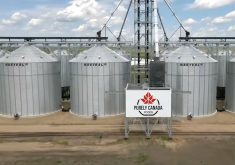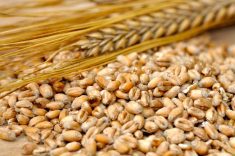The best cure for high prices is prices — as the old saying goes — but Canadian grain producers may be able to ride the current highs for a little longer yet.

“We’re approaching all-time highs in a number of commodities right now, and historically, the faster things go up, the faster they inevitably go back down again,” said Mike Jubinville, senior market analyst with MarketsFarm.
“But what I haven’t seen yet is clear evidence that demand is slowing down, even at today’s high prices. We’re looking at canola at $16 a bushel, feed barley at $6-plus a bushel, and wheat in the $8-a-bushel area now — all these are very high prices, but the demand for the product is still intact.
“A lot of the upward momentum in the marketplace has been tied to this demand. I don’t see any fall-off there yet.”
That “extraordinary” momentum is partly the result of the “demand-pull environment” the world finds itself in for the first time in a decade, said Jubinville.
Read Also

New crop insurer policy enables easier startup for faba beans
Agriculture Financial Services Corporation updated its normals for faba beans, which may open the door for more Canadian producers to feel comfortable growing the pulse crop in the future.
“A lot of rallies that we do see in agriculture tend to be from supply shortage issues that help lift the markets, and those can have dramatic impacts on prices but tend to be short lived as growers respond and flood the marketplace. It’s kind of straight up, straight down,” he said.
“But demand-pull environments are something very different. The momentum to pull grains out of exporting countries and into areas that need it has given upward momentum to prices that we haven’t seen in years.”
And China is at the epicentre of that demand, he said.
Following a trade war with the U.S. that started in 2018, China began to curb its agricultural imports from the States, using its own stockpile of grains that have steadily been declining over the past few years.
On top of that, China has been on an “aggressive program” to rebuild its decimated hog herd following the African swine fever outbreak in 2019 that cut its herd by nearly half. So demand for feed grains has picked up even as domestic feed grain supplies in China have been dwindling.
But there are other factors at play, Jubinville added.
Carry-out levels for soybeans and corn in the U.S. and canola in Canada are “uncomfortably tight,” and as the pandemic drags on, overbuying could continue as countries shift from their typical just-in-time delivery system to “rebuilding reserves just in case.”
“Because of the tight inventories that we’re looking at in terms of ending stocks across a lot of the spectrum of a lot of these commodities, there’s no room for any production hiccup,” he said, adding the focus right now is on South America’s production as a result of dry conditions driven by La Niña.
The combination of higher demand and tighter supplies has created some good pricing opportunities for producers — and Jubinville doesn’t see that changing any time soon.
“I haven’t seen yet that the demand element of the marketplace has backed off, and I don’t think we’ve got the price high enough yet to curb that demand. How long that lasts for is anybody’s guess.”
Don’t wait too long
So right now, producers should try to capture those high prices while they can, said Brennan Turner, founder and CEO of FarmLead.

“When push comes to shove, locking in anywhere between 10 to 30 per cent right now is not a bad idea, especially in crops like the low-protein wheat or canola,” he said.
“If prices stay elevated, I wouldn’t be surprised to see more people get even more sold on new crop contracts — maybe 50 per cent on some of the pulses or the oilseeds.”
How much producers should lock in right now depends on their balance sheet and their risk tolerance. Before even looking at price levels, producers need to understand their break-even numbers and their cash flow needs.
“That’s a game plan I think every farmer should employ,” said Turner. “Once you know your numbers, you can track against them, and hopefully it results in a better balance sheet.”
But given that La Niña could affect production in Canada here, too, Turner isn’t suggesting selling the entire crop on a forward contract basis. Rather, he recommends locking in 20 to 30 per cent to “guarantee yourself some sort of profit and cash flow come harvest time.”
“Then, if you do start to see some weather premiums creep in the market come May and June, that’s another selling opportunity that you rarely see around that time and it shouldn’t be ignored,” he said.
“By the time we get to July or August, being in that 40 to 60 per cent sold standpoint isn’t a bad idea.
“It’s important that farmers be cognizant that high prices don’t stay forever. It’s a matter of reducing your exposure to the market and ensuring your balance sheet is a little bit stronger by making some of these new crop sales.”
Some farmers are reluctant to contract any of their crop until it’s off the field, but that’s not the best strategy either.
“You have to ask yourself how many times in all your years of farming have you not produced at least 10 per cent or 20 per cent of what you expected to,” said Turner. “For those who are a little bit skeptical of contracting more than what they would normally do, this is about reducing your exposure to the market with the reality that you are likely to produce a crop.”
Some of the best new crop pricing opportunities tend to be found toward the end of January and in the early part of February, he added, so now is the right time to be thinking about how to take advantage of these high prices while they last.
“At the end of the day, the market is rewarding us right now in terms of prices, so make a sale when you can,” said Turner.
“Take a profit when you can, not when you have to.”















